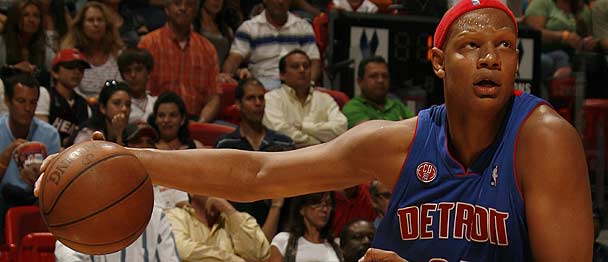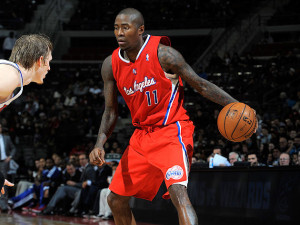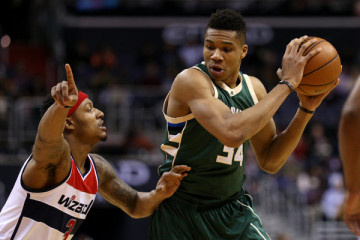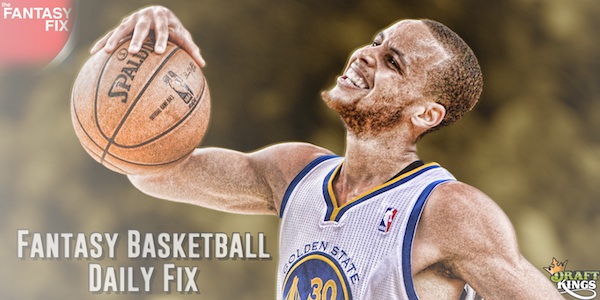One Side of the Ball: Offense Reins Supreme

Last week Major League Baseball celebrated the 40th anniversary of the designated hitter. The position, originally constructed to inject more offense into an otherwise slowing game, has added new life to the sport while singlehandedly deitizing one-dimensional players like Edgar Martinez, Frank Thomas, and Harold Baines.
The sport of basketball fails to lend itself to such a position but one must wonder what would happen if the NBA could somehow support players who played on just one side of the ball. Aside from superficial stats like rebounds, blocks, and steals, very few commonly used measurements consider the other half of basketball, the defensive end.
Today we explore the concept of the NBA’s version of the designated hitter: players whose lone task is to play and facilitate offense. The players mentioned below may fail to earn the playing time their offensive peripherals may suggest for the simple reason that they are in fact offensive players.
Jamal Crawford: Compiling this list wasn’t difficult. What was difficult however was deciding who plays the most lackluster defense while simultaneously bringing elite-level offense to the court. Hands down Jam Crawford wins here.

Many thought that New Orleans won the lottery last summer in landing franchise pillar Anthony Davis when in fact the real winner of last offseason was Jamal Crawford. After suiting up for five teams over the past four years, Crawford has found his basketball bliss on a team that needs him to do what he does best: score the ball.
The veteran guard has done just that. Crawford has been given generous looks at the basket considering he hasn’t started a game all season, and leads the Clippers in shots per game (13.5), ahead of proven scorers like Chris Paul, Blake Griffin, and Caron Butler.
The offensive honeymoon gets even sweeter for the former Michigan Wolverine. 2013 is proving to be one of Crawford’s best shooting seasons overall. A near career best 44% from the field makes him a reliable weapon for Los Angles who will need the talented combo-guard to slash versus weak interior teams and stretch defenses with his improved perimeter range.
Without question Crawford is the biggest difference between this season and last for a supremely skilled team. With defensive responsibility delegated to players like Matt Barnes, Eric Bledsoe, and DeAndre Jordon, Jamal Crawford has found his own Eden on Figueroa Street in Los Angeles.
Charlie Villanueva: The remaining two years of Charlie Villanueva contact is the only thing uglier than watching the 6’11’’ forward settle into a defensive stance. Scouts long overlooked his shortcomings because of his versatility once the ball crosses half court.
A former lottery pick, and the owner of a 5-year $38MM contract awarded before the 2009-2010 season, Charlie V displayed shown flashes of his offensive aptitude but has shown Detroit nothing more than a lackluster effort without the ball in his hands.
Though his shooting numbers suggest otherwise (an abysmal 38%/34%/55%), the former UCONN Husky has the capability to contribute quite a bit offensively. A career 44%/35%/78% garners hope that given extended time Villanueva has the overall skills to contribute—at least offensively.
The lowly Pistons aren’t the right fit for Villanueva and his albatross of a contract is nearly impossible to move should a team desire a versatile scoring threat. All this together leaves this talented offensive weapon to rust buried at deep end of Detroit’s bench.
Steve Novak: Last July the Knicks extended their sharp-shooting threat Steve Novak, giving him a 4-year $15MM extension to simply shoot the basketball and function as a perimeter threat. Having him on the floor has done wonders for Carmelo Anthony and Ray Felton, two players who are enjoying superb offensive seasons (A career best 28.3 PPG for Anthony and a respectable 14 PPG for Felton while also serving as the team’s distributor).
New York understands that the former Marquette star won’t be seeing minutes guarding Jeff Green or Loul Deng come playoff time, but the Knicks have long tried to hide him while still reaping the benefits of his offense. For the most part Mike Woodson and co. have been quite successful in doing this and one might even think that Novak could perhaps be a functional defender. He has quite a bit going for him: Novak is long—at 6’10’’ he’s usually asked to guard opposing small forwards who are three –four inches shorter and he has average lateral quickness which may make it easier to keep him on the floor during tight 4th quarter situations.
Ultimately Steve Novak won’t ever lose the label as a “below-average” and opposing wings will forever become giddy at the prospect of a Novak matchup. Those in The Big Apple will however enjoy the marksmanship of one of the game’s best jump shooters for the next four years.
Nick Young: It was a surprise to see the trade deadline pass and Nick Young still find himself a member of the 76ers. Teams like Chicago and Memphis who both find themselves in the bottom 1/3rd of the league in total offense could have benefited from Young’s relentless offensive attack—even if it does mean conceding a bit on defense.
Young has never been given an opportunity at major minutes on any of the three teams he’s played for mostly because of his dreadful defensive effort. The intrigue lies in what he’s able to do in just limited action. While never logging more than 31 nightly minutes for any team, Young has posted yearly scoring averages just short of 20 PPG.
This summer the former USC standout will hit the open market with the intention of latching on with a contender who can afford to let Young attack the rim and catch his breath on defense.
Mike Dunleavy: Dunleavy’s matador defense has kept the former Duke Blue Devil from ever becoming the player fans once expected when he was drafted 3rd overall in 2002. At 6’9’’ he’s able to earn his keep by scoring the ball from multiple positions and his long arms plus a high release will likely help him find employment in coming years.
Like Steve Novak, Dunleavy has carved out a niche for himself as an elite shooter and has made this season a high-water-mark. Posting a career best 43% from three has made Dunleavy the stereotypical offensive specialist.



